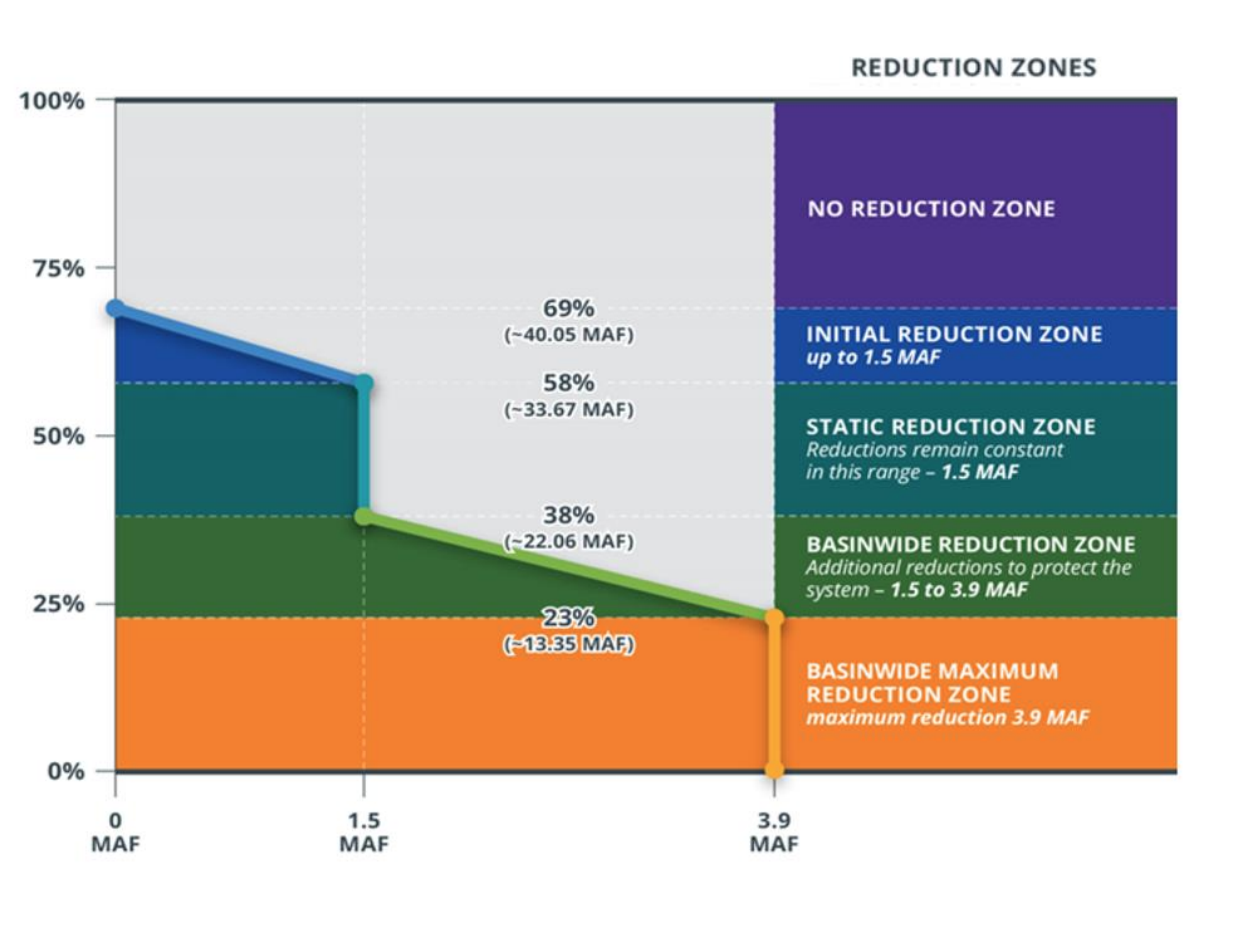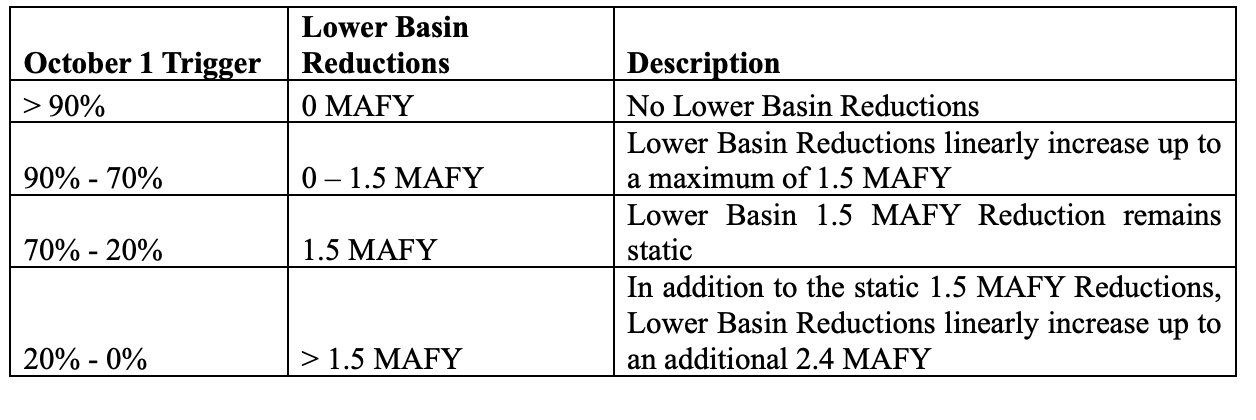States in the upper and lower halves of the Colorado River basin have unveiled conflicting visions on which path the Bureau of Reclamation should follow when crafting a new framework governing water cuts after the current guidelines’ 2026 expiration.
Negotiators from both sides disagree over whether downstream water users Arizona, California and Nevada should continue to bear the brunt of cuts in times of severe shortage or if additional burden should be extended upstream to Colorado, New Mexico, Utah and Wyoming, according to plans proposed to the Bureau of Reclamation last week.
The Lower Basin states’ plan proposes cuts of up to 1.5 million acre-feet annually if the Colorado River basin’s “total system contents” — the amount of water in Flaming Gorge, Blue Mesa, Navajo, Powell, Mead, Mohave, and Havasu — drop below 58% full. This is, in part, meant to help the Lower Basin account for the “structural deficit” causing water losses in Lake Mead each year, which is partially driven by evaporation and river seepage, according to a press release from the Colorado River Board of California.
If the system were to fall below 38% of its normal capacity under the Lower Basin proposal, both basins would be subject to a combined curtailment of up to 3.9 million acre-feet annually, including the Lower Basin’s 1.5-million-acre-foot cut. The extra reductions would be split, with the Lower Basin states and Mexico responsible for 50% and the Upper Basin states responsible for 50%, according to the proposal.
The Upper Basin plan, on the other hand, similarly proposes the Lower Basin take up to 1.5 million acre-feet of cuts in years when Lakes Powell and Mead — the system’s two primary reservoirs — sink below 70% of their 8.5-million-acre-foot capacity. Their plan would require Arizona, Nevada and California to take up to 2.4 million acre-feet of additional reductions on top of the 1.5-million-acre-foot cut if both reservoirs were less than 20% full.
“The big disagreement is — after the structural deficit gets taken care of by the Lower Basin, should the Lower Basin continue shouldering all the cuts or should the cuts be spread across states in the Upper Basin, in the Lower Basin and in Mexico?” said Elizabeth Koebele, an associate professor of political science at the University of Nevada-Reno.
 Reductions under Lower Colorado River Basin proposal. Source: Lower Basin Proposal
Reductions under Lower Colorado River Basin proposal. Source: Lower Basin ProposalThe Colorado River is governed by a complex set of long-standing agreements, federal laws, and court decisions collectively deemed the “Law of the River.” The Colorado River Compact of 1922, one of the river’s foundational governing documents, formally split apart the Upper and Lower Basins and allocated 7.5 million acre-feet of water to each.
Upper Basin water users rely heavily on snowpack and runoff; their half of the basin is less reliant on reservoirs and if they aren’t able to make use of the water they do get, it heads downstream, according to Utah’s Colorado River Commissioner Gene Shawcroft. Lower Basin users’ water allocations, in contrast, are initially stored in major reservoirs upstream, leaving them with a firmer picture of how much water they will have access to in the coming year.
This means Upper Basin states have been forced to use less water in years when snowpack there is scarce. In 2021, for example, they used only 3.5 million acre-feet of their 7.5-million acre-foot allocation. The Lower Basin states, on the other hand, used around 7 million acre-feet, which they received from upstream reservoirs.
It’s easy to be “in the know” about what’s happening in Washington, D.C. Sign up for a FREE month of Agri-Pulse news! Simply click here.
“There are many, many years when we simply don’t have the opportunity to use more water. Not because we couldn’t collect it or we couldn’t deliver it — it’s just because the water’s not there,” Shawcroft told Agri-Pulse. “So when we get to that point, if the Lower Basin expects us to meet some kind of an obligation for water that potentially doesn’t exist, that creates an untenable situation because there’s just no water to deliver downstream.”
The Upper Basin also must consider evaporative losses in its water accounting, something the Lower Basin previously has not been required to do. This factors into the “structural deficit” the Lower Basin committed to addressing with the proposal.
Upper Basin negotiators, in their proposal, did suggest they would look at “voluntary, temporary, and compensated reductions of consumptive use” if Reclamation were to approve the agreement. They stressed, however, that these “parallel activities” would remain separate from any formal action taken by Reclamation. Shawcroft pointed to the Upper Colorado River Commission’s System Conservation Pilot Program, which offers farmers and other water users money for each acre-foot of water they conserve, as one potential example.
Negotiators for the Lower Basin states, however, argue the burden of additional cuts needs to be split more broadly.
“Each basin, state, and sector must contribute to solving the challenges ahead,” JB Hamby, California’s Colorado River Commissioner, said in a press release. “No one who benefits from the river can opt out of saving it.”
Lower Basin negotiators, particularly those from Arizona and California, have struggled to settle their own differences over how big their cuts should be. California is the river’s largest water user, with a 4.4-million-acre-foot allocation. Many of the state’s water users have long-standing rights to water from the river, and California water officials have tightly guarded that level of access in previous negotiations.
Arizona, which is allocated around 2.85 million acre-feet of water annually, has so far taken the brunt of previous reductions. Most of these cuts came from the Central Arizona Project, a 336-mile aqueduct system that delivers Colorado River water to central and southern Arizona.
Congressional approval of the aqueduct in 1968 required Arizona’s lawmakers to make one concession: In times of drought, the Central Arizona Project would be the first lower basin user to take cuts. But because it is a primary water source for the fast-growing metropolitan regions of Phoenix and Tucson, as well as for tribes in the region, state officials are worried about water levels dropping low enough to cut off access to the reservoir entirely.
Under the “static reductions” proposed by the Lower Basin states, Arizona would lose 760,000 acre-feet if total system contents fall below 58%, while California and Nevada would see 440,000 and 50,000 acre-feet slashed, respectively. Mexico would see reductions of 250,000 acre-feet under that scenario. These states and Mexico would then split the responsibility for the 3.9 million acre-feet of potential additional cuts with the upper basin states.
 Reductions under Upper Basin proposal based on “Trigger” or combined storage of Lakes Powell and Mead. Source: Upper Basin proposal
Reductions under Upper Basin proposal based on “Trigger” or combined storage of Lakes Powell and Mead. Source: Upper Basin proposalKoebele said under the proposed framework, the Central Arizona Project would continue to feel the main impact of Arizona's cuts. Dan Jones, a lawyer representing agricultural clients in the counties served by the Central Arizona Project agreed, noting that it would leave very little — if any — CAP water for agricultural use.
Jones added that the Upper Basin proposal could pose an even greater impact to CAP water users since it assigns the Lower Basin 2.4 million acre-feet of additional reductions on top of the 1.5-million-acre-foot cut if Lakes Powell and Mead are less than 20% full.
“That proposal would be pretty harsh for the Lower Basin in general,” Jones said.
While the proposals reflect the current positions of negotiators in both sides of the basin, Koebele said she's not yet concerned about a lack of a consensus between the two basins. The proposals, she said, are just reflections of a negotiating process that is playing out “more publicly” than it has in the past.
“This kind of negotiating and going back and forth and putting alternatives and options on the table, this always happens,” she said.
Shawcroft, similarly, said he and other negotiators originally sat down at the table with a mission to craft one seven-state alternative.
“That's still the goal,” Shawcroft said.
For more news, go to Agri-Pulse.com.


